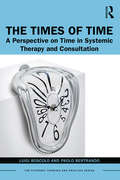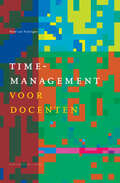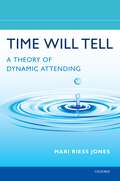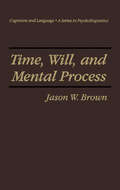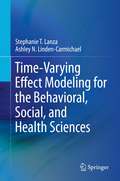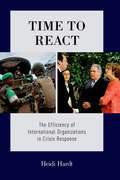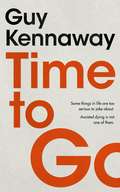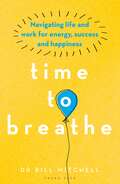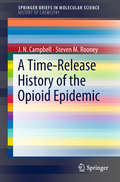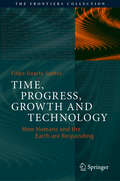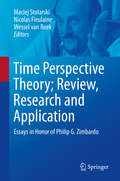- Table View
- List View
The Times of Time: A Perspective on Time in Systemic Therapy and Consultation (The Systemic Thinking and Practice Series)
by Luigi Boscolo Paolo BertrandoThis is the most comprehensive study of the role of time in psychotherapy. It illustrates how time is experienced in different ways – individual time, family time, and social time – and how time can act as an invaluable metaphor in shaping clinical practice within a systemic approach, while maintaining connections with other approaches, such as psychoanalysis and cognitive therapies. A seminal volume on this topic, the book looks at issues such as the duration of therapy; the relevance of past, present, and future in therapy; and the balance of memory and oblivion. It also includes a discussion of how time is framed in other disciplines, including sociology, history, and psychopathology, whilst exploring the concept in practical terms through case vignettes and complete case histories, including the transcripts of actual sessions. The reader is thus given a set of guidelines for dealing with time issues in therapy from a systemic perspective. Originally published in 1993, the book has been updated to create a dialogue with contemporary theoretical debates, as well as social and technological changes. It will fascinate all psychotherapists, particularly those interested in a systemic practice.
Timemanagement voor docenten (Docentenreeks)
by R. van KralingenIedere docent heeft regelmatig met piekbelasting in zijn onderwijspraktijk te maken. Ook structurele overbelasting komt in het onderwijs voor. Dit boek helpt docenten werkdruk in beeld te brengen en de oorzaken van werkdruk te achterhalen. Docenten worden in dit boek individueel en op teamniveau in staat gesteld werkdruk te lijf te gaan door hun kernactiviteiten te analyseren. Er worden allerlei tips en tools gegeven om tot efficiënte onderwijssessies, coachings– en begeleidingsessies, toetsen en beoordelingen, vernieuwingsoperaties en vergaderingen te komen. Er worden suggesties gegeven om werkdruk op korte én lange termijn te verminderen. Het ervaren van werkdruk blijft een persoonlijke zaak. Om tot zelfanalyse en vergelijking met collega's te komen, worden er verschillende instrumenten aangeboden.
Time Will Tell: A Theory of Dynamic Attending
by Mari Riess JonesAttention is a central concept in psychology. The term 'attention' itself has persisted, even though it implies a static, insulated capacity that we use when it is necessary to focus upon some relevant or stimulating event. Riess Jones presents a different way of thinking about attention; one that describes it as a continuous activity that is based on energy fluctuating in time. A majority of attention research fails to examine influence of event time structure (i.e., a speech utterance) on listeners' moment-to-moment attending. General research ignores listeners endowed with innate, as well as acquired, temporal biases. Here, attending is portrayed as a dynamic interaction of an individual within his or her surroundings. Importantly, this interaction involves synchronicity between an attender and external events. This emphasis on time and synchronicity distinguishes the author's theory, called Dynamic Attending Theory (DAT), from other approaches to attending which characterize attention metaphorically as a filter, resource pool, spotlight, and so on. Recent research from neuroscience has lent support to Riess Jones' theory, and the goal of this book is to bring this new research as well as her own to the wide audience of psychologists interested in attention more broadly.
Time Will Tell: A Theory of Dynamic Attending
by Mari Riess JonesAttention is a central concept in psychology. The term 'attention' itself has persisted, even though it implies a static, insulated capacity that we use when it is necessary to focus upon some relevant or stimulating event. Riess Jones presents a different way of thinking about attention; one that describes it as a continuous activity that is based on energy fluctuating in time. A majority of attention research fails to examine influence of event time structure (i.e., a speech utterance) on listeners' moment-to-moment attending. General research ignores listeners endowed with innate, as well as acquired, temporal biases. Here, attending is portrayed as a dynamic interaction of an individual within his or her surroundings. Importantly, this interaction involves synchronicity between an attender and external events. This emphasis on time and synchronicity distinguishes the author's theory, called Dynamic Attending Theory (DAT), from other approaches to attending which characterize attention metaphorically as a filter, resource pool, spotlight, and so on. Recent research from neuroscience has lent support to Riess Jones' theory, and the goal of this book is to bring this new research as well as her own to the wide audience of psychologists interested in attention more broadly.
Time, Will, and Mental Process (Cognition and Language: A Series in Psycholinguistics)
by Jason W. BrownIn this volume, distinguished neurologist Jason W. Brown extends the microgenetic theory of the mind by offering a new approach to the problem of time and free will. Brown bases his work on a unitary process model of brain and behavior. He examines the problem of subjective time and free will, the experiential present, the nature of intentionality, and the creative properties of physical growth and mental process.
Time Warped: Unlocking the Mysteries of Time Perception
by Claudia HammondTime rules our lives, but how much do we really understand it? In Time Warped, we meet the people willing to go to extreme lengths to find out. They travel to Costa Rica to find out if hummingbirds can sense the passage of time, they walk towards the edge of a stairwell blindfolded and one man spends two months in an ice cave in total darkness - all in an attempt to fathom the tricks time can play on our minds. Drawing on the latest research from psychology, neuroscience and biology, award-winning BBC Radio4 presenter Claudia Hammond delves into the mysteries of time perception. She shows us how to manage time more efficiently, why speeds up as you get older and, ultimately, how to use the warping of time to our own advantage.
Time-Varying Effect Modeling for the Behavioral, Social, and Health Sciences
by Stephanie T. Lanza Ashley N. Linden-CarmichaelThis book is the first to introduce applied behavioral, social, and health sciences researchers to a new analytic method, the time-varying effect model (TVEM). It details how TVEM may be used to advance research on developmental and dynamic processes by examining how associations between variables change across time. The book describes how TVEM is a direct and intuitive extension of standard linear regression; whereas standard linear regression coefficients are static estimates that do not change with time, TVEM coefficients are allowed to change as continuous functions of real time, including developmental age, historical time, time of day, days since an event, and so forth.The book introduces readers to new research questions that can be addressed by applying TVEM in their research. Readers gain the practical skills necessary for specifying a wide variety of time-varying effect models, including those with continuous, binary, and count outcomes. The book presents technical details of TVEM estimation and three novel empirical studies focused on developmental questions using TVEM to estimate age-varying effects, historical shifts in behavior and attitudes, and real-time changes across days relative to an event. The volume provides a walkthrough of the process for conducting each of these studies, presenting decisions that were made, and offering sufficient detail so that readers may embark on similar studies in their own research. The book concludes with comments about additional uses of TVEM in applied research as well as software considerations and future directions. Throughout the book, proper interpretation of the output provided by TVEM is emphasized.Time-Varying Effect Modeling for the Behavioral, Social, and Health Sciences is an essential resource for researchers, clinicians/practitioners as well as graduate students in developmental psychology, public health, statistics and methodology for the social, behavioral, developmental, and public health sciences.
Time to Listen to Children: Personal and Professional Communication
by Birgit Carolin Pat MilnerTime to Listen to Children is a practical guide to effective communication with children. Professionals working with children in a variety of settings examine the skills required to help children articulate their problems and feelings. They discuss issues such as training, cultural background and religion and give accounts of their work in the following settings: * education * social services * voluntary organizations * medical settings * law Contributors practice a variety of therapeutic techniques, including play, music and art therapy. Time to Listen to Children will be a valuable resource for social workers, teachers and counsellors in training and for all professionals who wish to adopt a skilled, reflective and active approach to their work with children.
Time to Listen to Children: Personal and Professional Communication
by Pat Milner Birgit CarolinTime to Listen to Children is a practical guide to effective communication with children. Professionals working with children in a variety of settings examine the skills required to help children articulate their problems and feelings. They discuss issues such as training, cultural background and religion and give accounts of their work in the following settings: * education * social services * voluntary organizations * medical settings * law Contributors practice a variety of therapeutic techniques, including play, music and art therapy. Time to Listen to Children will be a valuable resource for social workers, teachers and counsellors in training and for all professionals who wish to adopt a skilled, reflective and active approach to their work with children.
Time to Go
by Guy KennawayIn 2017 Susie Kennaway asked her son Guy to kill her.88 years old, with an older and infirm husband, Susie wanted to avoid sliding into infantilised catatonia. The son immediately started taking notes and Time to Go is the result.In turns a manual for those considering the benefits of assisted dying, a portrait of a mother son relationship, and a sympathetic description of old age, this book is a route map through the moral, legal, emotional, intellectual and practical maze that is the biggest issue facing the senior generations today: leaving life on their own terms.During their conversations about when and how to make Susie's final exit, some of the difficulties of their fractious relationship mellowed and some even melted, as the reality of what they were planning brought them together. Many elderly people, like Susie, have clearly stated that they wish to die in a manner and time of their choosing. But the church, the law, the medical profession and the pharmaceutical industry stand in the way, wagging their fingers. A change is coming for the rights of the elderly, the way it has come for the rights of women and gay people. Time to Go is a rallying call in this fight.Life is too precious not to be lived properly. As with a job, a relationship or a party, you have to know when it's time to go.
Time-to-Contact (ISSN #Volume 135)
by Heiko Hecht Geert SavelsberghTime-to-contact is the visual information that observers use in fundamental tasks such as landing an airplane or hitting a ball. Time-to-contact has been a hot topic in perception and action for many years and although many articles have been published on this topic, a comprehensive overview or assessment of the theory does not yet exist. This book fills an important gap and will have appeal to the perception and action community. The book is divided into four sections. Section one covers the foundation of time-to-contact, Section two covers different behavioral approaches to time-to-contact estimation, Section three focuses on time-to-contact as perception and strategy, and Section four covers time-to-contact and action regulation.
Time to Breathe: Navigating Life and Work for Energy, Success and Happiness
by Dr Bill MitchellThis book is for people who are struggling with the multiple demands of jobs that never seem to end and the complexities of their home lives. Struggling on without thinking through how to make it work can lead to exhaustion, unhappiness, burn-out or depression.Time To Breathe presents practical ideas that come out of Dr Bill Mitchell's clinical experience in getting people back to a zone of better energy, balance, fulfilment and more balanced ways of thinking about themselves. Through case studies of the everyday lives of people in many walks of professional life, we see how many of us can accidentally set off down a pathway that takes us away from our previously healthy robust selves - often without recognising it. When we can no longer stabilise our emotions and protect our energy we become overwhelmed, and rather than confident become self-doubting, guilty and anxious. This book describes three key building blocks of a balancing system to keep us within the energised healthy zone, in spite of the pressures we are under at work and at home. These are: self-awareness, an understanding of the physiology of energy, and a willingness to lead a more decisions-based life for better balance and effective working. Together, these form an overarching empowered mindset, freeing us from the mental habits that lead us to de-prioritise time for ourselves. And leading to far happier outcomes than feeling trapped and helpless, or walking away from career paths into which we have invested years of our lives.
Time to Breathe: Navigating Life and Work for Energy, Success and Happiness
by Dr Bill MitchellEver feel like you're so busy and stressed that you forget to breathe?Dr. Bill Mitchell is here to help. A psychologist who specialises in rebalancing the lives of the overwhelmed, overstressed and overscheduled, in this book Bill brings you tried and tested, practical solutions that will help you protect your energy and prioritise what is most important.Find out how to prevent the drift towards burnout and poor mental health that so many of us suffer from in our busy modern lives. Your family – and your boss – will thank you.
Time, Space and Phantasy (The New Library of Psychoanalysis)
by Rosine Jozef PerelbergTime, Space, and Phantasy examines the connections between time, space, phantasy and sexuality in clinical practice. It explores the subtleties of the encounter between patient and analyst, addressing how aspects of the patient’s unconscious past are actualised in the present, producing new meanings that can be re-translated to the past. Perelberg’s analysis of Freud’s Multi-dimensional model of temporality suggests that he always viewed the constitution of the individual as non-linear. In Freud’s formulations, the individual is decentred and ruled by different temporalities, most of which escape their consciousness. Perelberg identifies the similarities between this and Einstein’s theory of relativity which states that rather than being absolute, time depends on the relative position and speed of the observing individual suggesting that rather than being a reality, time is an abstraction, connecting objects and events. Throughout this text, Perelberg draws together connections between time, mental space, and phantasy showing how time is constantly reshaped in the light of new events and experiences. This book will be of interest to psychoanalysts, psychotherapists, psychologists, and social workers.
Time, Space and Phantasy (The New Library of Psychoanalysis)
by Rosine Jozef PerelbergTime, Space, and Phantasy examines the connections between time, space, phantasy and sexuality in clinical practice. It explores the subtleties of the encounter between patient and analyst, addressing how aspects of the patient’s unconscious past are actualised in the present, producing new meanings that can be re-translated to the past. Perelberg’s analysis of Freud’s Multi-dimensional model of temporality suggests that he always viewed the constitution of the individual as non-linear. In Freud’s formulations, the individual is decentred and ruled by different temporalities, most of which escape their consciousness. Perelberg identifies the similarities between this and Einstein’s theory of relativity which states that rather than being absolute, time depends on the relative position and speed of the observing individual suggesting that rather than being a reality, time is an abstraction, connecting objects and events. Throughout this text, Perelberg draws together connections between time, mental space, and phantasy showing how time is constantly reshaped in the light of new events and experiences. This book will be of interest to psychoanalysts, psychotherapists, psychologists, and social workers.
Time Series in Psychology
by R. A.M. GregsonFirst published in 1983. Routledge is an imprint of Taylor & Francis, an informa company.
Time Series in Psychology
by R. A.M. GregsonFirst published in 1983. Routledge is an imprint of Taylor & Francis, an informa company.
A Time-Release History of the Opioid Epidemic (SpringerBriefs in Molecular Science)
by J. N. Campbell Steven M. RooneyThis Brief takes the reader on a chemical journey by following the history for over two centuries of how an opiate became an opioid, thus spawning an empire and a series of crises. These imperfect resemblances of alkaloids are both natural and synthetic substances that, particularly in America, are continually part of a growing concern about overuse. This seemed an inviting prospect for those in pain, but as the ubiquitous media coverage continues to lay bare, the levels of abuse point to the fact that perhaps an epidemic is upon us, if not a culture war. Seeking answers to how and why this addiction crisis transpired over two hundred years of long development, this Brief examines the role that the chemistry laboratory played in turning patients into consumers. By utilizing a host of diverse sources, this Brief seeks to trace the design and the production of opioids and their antecedents over the past two centuries. From the isolation and development of the first alkaloids with morphine that relieved pain within the home and on the battlefield, to the widespread use of nostrums and the addiction crisis that ensued, to the dissemination of drugs by what became known as Big Pharma after the World Wars; and finally, to competition from home-made pharmaceuticals, the progenitor was always, in some form, a type of chemistry lab. At times, the laboratory pressed science to think deeply about society's maladies, such as curing disease and alleviating pain, in order to look for new opportunities in the name of progress. Despite the best intentions opioids have created a paradox of pain as they were manipulated by creating relief with synthetic precision and influencing a dystopian vision. Thus, influence came in many forms, from governments, from the medical community, and from the entrepreneurial aspirations of the general populace. For better, but mostly for worse, all played a role in changing forever the trajectory of what started with the isolation of a compound in Germany. Combining chemistry and history in a rousing new long-form narrative that even broadens the definition of a laboratory, the origins and future of this complicated topic are carefully examined.
Time, Progress, Growth and Technology: How Humans and the Earth are Responding (The Frontiers Collection)
by Filipe Duarte SantosThis book addresses the current challenges of sustainable development, including its social, economic and environmental components. The author argues that we need to develop a new concept of time based on inter-generational solidarity, which focuses both on the long- and the short term. The evolution of man's notions of time are analyzed from prehistory to modern times, showing how these concepts shape our worldviews, our ecological paradigms and our equilibrium with our planet. Practical approaches to dealing with the major medium- and long term sustainability challenges of the 21st century are presented and discussed. This is a thought provoking and timely book that addresses the main global socioeconomic and environmental challenges facing the current and future generations, using science-based analysis and perspectives. It presents an historical narrative of the advent of progress, economic growth and technology, and discusses the structural changes needed to co-create sustainable pathways. It provides hope for our future on Earth, mankind’s common home. António Guterres, Secretary-General of the United Nations This is an amazing, almost mind-boggling book. The author takes a look at the true whole, i.e., the development of the human enterprise since its very beginning. This enterprise is evidently a possibility under the boundary conditions of cosmological dynamics and natural evolution, but evidently also a highly improbable one. It is all but a miracle that the Earth system in its present form exists and happens to support a technical civilization. Will this civilization last long, will it transform itself into something even more exceptional, or will it perish in disgrace?Santos dares to address these grandest of all questions, equipped with a unique transdisciplinary wisdom drawing on physics, cybernetics, geology, biology, economics, anthropology, history, and philosophy. And he dares to dive into the deepest abysses of thinking, where categorial monsters like time and progress lurk. Thereby, he takes us on fascinating journey, during which we perceive and grasp things we have never seen and understood before. One of the best essays I have ever read. John Schellnhuber, founding director of the Potsdam Institute for Climate Impact Research (PIK) and former chair of the German Advisory Council on Global Change
Time Pressure and Stress in Human Judgment and Decision Making
by A. JohnMaule OlaSvensonSome years ago we, the editors of this volume, found out about each other's deeply rooted interest in the concept of time, the usage of time, and the effects of shortage of time on human thought and behavior. Since then we have fostered the idea of bringing together different perspectives in this area. We are now, there fore, very content that our idea has materialized in the present volume. There is both anecdotal and empirical evidence to suggest that time con straints may affect behavior. Managers and other professional decision makers frequently identify time pressure as a major constraint on their behavior (Isen berg, 1984). Chamberlain and Zika (1990) provide empirical support for this view, showing that complaints of insufficient time are the most frequently report ed everyday minor stressors or hassles for all groups of people except the elderly. Similarly, studies in occupational settings have identified time pressure as one of the central components of workload (Derrich, 1988; O'Donnel & Eggemeier, 1986).
Time Present and Time Past: Selected Papers of Pearl King
by Pearl KingThis remarkable collection of papers is divided into three sections: clinical issues; psychoanalysis and the life cycle; and underlying theories of practice. The papers span the years 1951 to 2004, recording five decades of British psychoanalysis, through various angles. The papers in the clinical part include a unique, lengthy case study of the psychoanalysis of a four-year-old boy, and a follow-up of his life over five decades later. After reading the paper at the age of 54, the patient agreed to write his own version of his life, which is included in the book. The second part of the book, on psychoanalysis and the life cycle, includes renowned chapters on ageing. The author looks at the ageing psychoanalyst as well as the characteristics of analysis with older patients. The third part discusses the theories underlying the author's practice and puts forward her views on such concepts as alienation, transference, and the importance of time in psychoanalytic work with patients.
Time Present and Time Past: Selected Papers of Pearl King
by Pearl KingThis remarkable collection of papers is divided into three sections: clinical issues; psychoanalysis and the life cycle; and underlying theories of practice. The papers span the years 1951 to 2004, recording five decades of British psychoanalysis, through various angles. The papers in the clinical part include a unique, lengthy case study of the psychoanalysis of a four-year-old boy, and a follow-up of his life over five decades later. After reading the paper at the age of 54, the patient agreed to write his own version of his life, which is included in the book. The second part of the book, on psychoanalysis and the life cycle, includes renowned chapters on ageing. The author looks at the ageing psychoanalyst as well as the characteristics of analysis with older patients. The third part discusses the theories underlying the author's practice and puts forward her views on such concepts as alienation, transference, and the importance of time in psychoanalytic work with patients.
Time Perspective Theory; Review, Research and Application: Essays in Honor of Philip G. Zimbardo
by Maciej Stolarski Nicolas Fieulaine Wessel Van BeekThis book is about time and its powerful influence on our personal and collective daily life. It presents the most comprehensive and up-to-date overview of contemporary knowledge on temporal psychology inspired by Zimbardo's work on Time Perspective (TP). With contributions from renowned and promising researchers from all over the globe, and at the interface of social, personality, cognitive and clinical psychology, the handbook captures the breadth and depth of the field of psychological time. Time perspective, as the way people construe the past, the present and the future, is conceived and presented not only as one of the most influential dimensions in our psychological life leading to self-impairing behaviors, but also as a facet of our person that can be de-biased and supportive for well-being and happiness. Written in honor of Philip G. Zimbardo on his 80th birthday and in acknowledgement of his leading role in the field, the book contains illustrations of the countless studies and applications that his theory has stimulated, and captures the theoretical, methodological and practical pathways he opened by his prolific research.
Time Perspective: Theory and Practice
by Derek Chadee Aleksandra KostićThis book focusses on the theory and application of ‘time perspective theory’. Time perspective can be an important factor in determining psychological well-being and the way we see our world and others around us. The unique contemporary nature of this theory’s evolution has spurred great interest over the last 20 years. The editors responded to this interest by bringing together contributors across a multitude of subjects and perspectives to facilitate an unprecedented discussion on the topic; covering areas such as financial health, psychotherapy across adulthood and old age, prenatal past, metacognition, community and change, fear of crime and intrinsic motivations. The interdisciplinary nature of this project makes it of interest to a wide cross-section of academics and practitioners including psychologist, social workers, criminologists and anyone who has or wishes to adopted time perspective theorization to assist them in their understanding.
